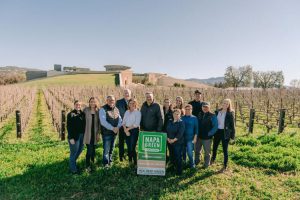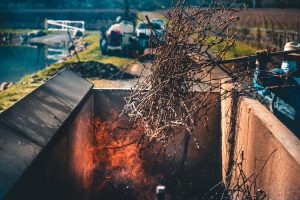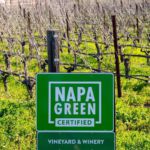Fast forward to the arrival of Chris Lynch, Opus One CEO, in 2020 and a focused effort to do our part to develop a “greenprint” for the planet. In early 2021 every Opus One employee participated in the creation of our 2030 Vision, an extension of our founders’ vision. There are five pillars, one of which is global sustainability. It has become our obsession.
The Climate Connection: One winery’s 'Greenprint'
- napa valley register | MICHAEL SILACCI |
- March 28, 2022
It only takes a tiny scratch in a flute to allow bubbles to flow from Champagne. It takes just a few people to initiate change AND a village to make it so. There is a best-fit leader for any project or task.
The Orbital Org Chart at Opus One winery in Oakville illustrates this for our vineyard, winemaking and facility teams. The chart is a three-dimensional diagram traced on a yoga ball. Bounce the ball, read the name on top, and we can tell you what that person can do better than anyone else on our team.
It reinforces the fact that people are our greatest resource. We work together to fulfill the vision of our two founders, Robert Mondavi and Baron Philippe de Rothschild. Their vision was that Opus One would be a classic red wine made from Bordeaux varieties, a wine shared with friends and family, and a place where people are stewards and leave Opus One better than they found it.
David Pearson, the former Opus One CEO, asked me in 2005, “What will we answer when our grandchildren ask, ‘What did you do to protect the planet from climate change?’”
We have consistently looked for ways to save energy and water and minimize our carbon footprint. In 2001 we reduced irrigation volumes by 40 percent compared to past practices. We imposed very simple rules in the cellar, for example: push-broom solids, shovel solids, rinse and squeegee. Do not push solids with water! We stopped watering our one-acre grass berm and are working with a landscape architect to create a landscape that is more harmonious with Mother Nature. Although our efforts in the winery and vineyard have been validated through certification by Napa Green and Napa Green Vineyard, respectively, we know we are far from the perfect shade of green.
We have taken longer than usual to determine the rootstock, variety, clone, spacing and row orientation in a 12 1/2 acre block of the Napa River Parcel along Highway 29. It will be our blueprint for future plantings. We installed a row orientation trial with three rows per treatment running True North, Magnetic North, and True North plus four different degrees of orientation.
We observed shading from one row to the next in the late afternoon at the hottest time of the day in early October. At that time of the year, any accessible water is in the deeper soil horizons and leaves are older and less efficient. We called this trial Panel Discussion, as we are debating the best row orientation to use. We will repeat the trial during the 2022 growing season.
In early 2018 we experimented with low smoke burn piles. We had not burned brush, nor used sulfur dust since 2003, because we no longer wanted to contribute to air pollution. However, low smoke burns provided us with the opportunity to create biochar by stopping the fire before the wood turned to ash. Davie Piña of Piña Vineyard Management purchased a Firebox by Air Burners in 2020, and we used it in spring 2020.
The biochar resembles black truffles from Perigord. Since we were burning wood from our To Kalon North vineyard, we named the biochar To Kalon Truffles. The black truffle has a symbiotic relationship with oak trees, facilitating the uptake of water and nutrients to the oak tree in exchange for sugars. Similarly, biochar facilitates the uptake of water and nutrients by the grapevine.
We have been discussing different ways to sequester carbon dioxide the past couple of years with Roger Boulton, UC Davis distinguished professor emeritus. Inspired by the efforts of Diana Snowden and Hailey Trefethen to compress carbon dioxide for reuse in other applications and industries, we will participate in a pilot program with Earthly Labs this vintage.
Earthly Labs can create dry ice or beverage-grade carbon dioxide. A small bucket of dry ice can be put on the top of a finished fermentation undergoing extended maceration, a technique used to polish rough tannins and increase the perception of concentration of wine post-fermentation as the skins remain in contact with the wine. The dry ice protects the lot from unwanted microbes and oxidation. It is a way to reuse carbon dioxide. Beverage-grade carbon dioxide can be reused by breweries.
It is important to move beyond recycling to reuse. We are exploring ways to remove labels from bottles used to serve guests. The bottles can be washed and refilled with a future vintage of wine.
But let’s be realistic — it is difficult to get folks to put items for recycling in the blue bin, food and materials in the compost bin, and waste in the trash bin. All too often people will contaminate the recycling bin with soiled materials, rendering plastic and aluminum cans unsuitable for recycling.
As Roger Boulton said to me at the Climate Change Leadership Summit in Porto, Portugal in 2019, “Until people wake up in the middle of the night thinking about climate change, nothing will be done to reverse it.”
It is time we woke up in the middle of the night.
• Follow the countywide Climate Action Committee meetings to learn what’s on their agenda, or attend a city council or county supervisor meeting to let your voice be heard.
• Attend a Zoom forum for Board of Supervisor Candidates on April 14 at 6:30 p.m. hosted by Napa Climate NOW! and the Napa Housing Coalition. Hear how candidates will work on climate and housing issues. Register for the forum at napa.350bayarea.org/events.
Michael Silacci serves as president of the Napa Valley Grapegrowers and serves on the Napa County Housing Commission. He recently began his 22nd year as winemaker at Opus One in Oakville.
Napa Climate NOW! is a local non-profit citizens’ group advocating for smart climate solutions based on the latest climate science, part of 350 Bay Area. Like, comment, and share our daily Facebook, Instagram, and Twitter posts @napaclimatenow or visit us at: http://napa.350bayarea.org
Making the commitment to third party certification takes time and effort, but it is worth it to demonstrate our commitment to the community and to protect our watershed, our land and the air we breathe.
- Susan Boswell, Chateau Boswell Winery




